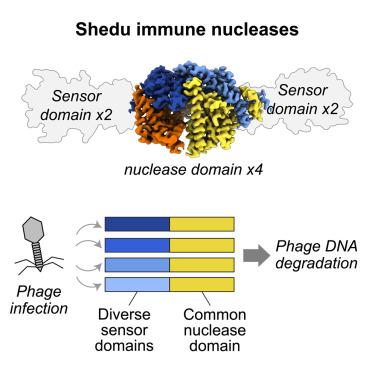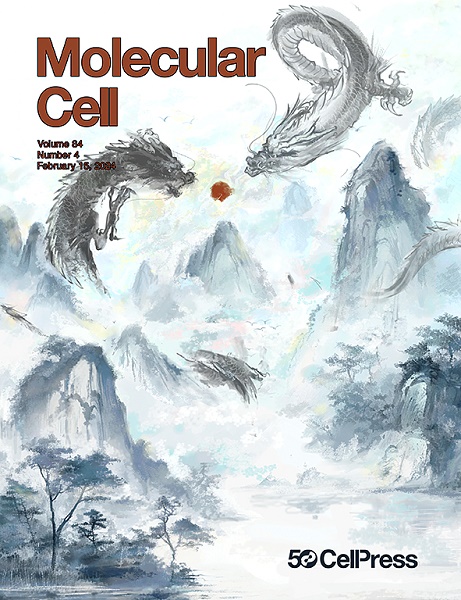细菌谢杜免疫核酸酶有一个共同的酶核,由不同的传感器结构域调控
IF 14.5
1区 生物学
Q1 BIOCHEMISTRY & MOLECULAR BIOLOGY
引用次数: 0
摘要
原核生物具有多种抗噬菌体免疫系统,包括单蛋白谢杜核酸酶。在此,我们揭示了蜡样芽孢杆菌谢杜活化的结构基础。谢杜蛋白的两种低温电子显微镜结构表明,它通过影响活性位点结构的构象变化在非活性和活性状态之间切换,这是由蛋白质的n端结构域(NTD)控制的。我们发现蜡样芽孢杆菌Shedu在DNA末端附近有一个3 '单链悬垂,可能使它能够特异性地降解某些噬菌体注入的DNA。生物信息学分析揭示了一个保守的核酸酶结构域,具有显著不同的n端调控结构域:我们鉴定出79种不同的NTD类型,分为8大类,包括预测核酸结合,酶和其他活性的NTD类型。总之,这些数据揭示了Shedu是一个广泛的免疫核酸酶家族,具有一个共同的核酸酶核心,由不同的ntd调节,可能对一系列信号作出反应。本文章由计算机程序翻译,如有差异,请以英文原文为准。

Bacterial Shedu immune nucleases share a common enzymatic core regulated by diverse sensor domains
Prokaryotes possess diverse anti-bacteriophage immune systems, including the single-protein Shedu nuclease. Here, we reveal the structural basis for activation of Bacillus cereus Shedu. Two cryoelectron microscopy structures of Shedu show that it switches between inactive and active states through conformational changes affecting active-site architecture, which are controlled by the protein’s N-terminal domain (NTD). We find that B. cereus Shedu cleaves near DNA ends with a 3′ single-stranded overhang, likely enabling it to specifically degrade the DNA injected by certain bacteriophages. Bioinformatic analysis of Shedu homologs reveals a conserved nuclease domain with remarkably diverse N-terminal regulatory domains: we identify 79 distinct NTD types falling into eight broad classes, including those with predicted nucleic acid binding, enzymatic, and other activities. Together, these data reveal Shedu as a broad family of immune nucleases with a common nuclease core regulated by diverse NTDs that likely respond to a range of signals.
求助全文
通过发布文献求助,成功后即可免费获取论文全文。
去求助
来源期刊

Molecular Cell
生物-生化与分子生物学
CiteScore
26.00
自引率
3.80%
发文量
389
审稿时长
1 months
期刊介绍:
Molecular Cell is a companion to Cell, the leading journal of biology and the highest-impact journal in the world. Launched in December 1997 and published monthly. Molecular Cell is dedicated to publishing cutting-edge research in molecular biology, focusing on fundamental cellular processes. The journal encompasses a wide range of topics, including DNA replication, recombination, and repair; Chromatin biology and genome organization; Transcription; RNA processing and decay; Non-coding RNA function; Translation; Protein folding, modification, and quality control; Signal transduction pathways; Cell cycle and checkpoints; Cell death; Autophagy; Metabolism.
 求助内容:
求助内容: 应助结果提醒方式:
应助结果提醒方式:


